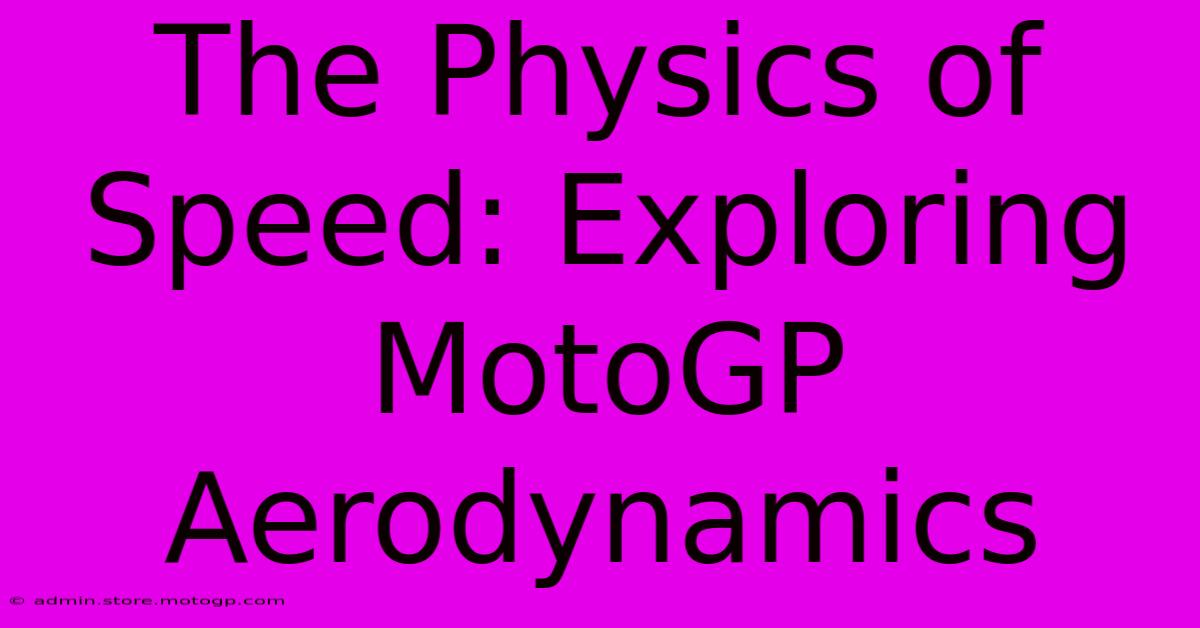The Physics Of Speed: Exploring MotoGP Aerodynamics

Table of Contents
The Physics of Speed: Exploring MotoGP Aerodynamics
MotoGP. The pinnacle of motorcycle racing. The roar of the engines, the breathtaking speeds, the hair-raising overtakes – it's a spectacle defined by pushing the boundaries of what's possible. But behind the thrill and the drama lies a complex interplay of physics, and nowhere is this more evident than in the sophisticated aerodynamics of the machines. This article dives deep into the science behind the speed, exploring how MotoGP bikes utilize aerodynamic principles to achieve unparalleled performance.
Understanding Aerodynamic Forces
Before we delve into the specifics of MotoGP aerodynamics, let's establish a basic understanding of the forces at play. As a bike speeds down the track, it interacts with the air, creating several key aerodynamic forces:
-
Downforce: This is the force pushing the bike downwards, crucial for high-speed stability. It's generated by carefully designed aerodynamic components that manipulate airflow. More downforce means greater grip, allowing riders to lean into corners at higher speeds and accelerate harder out of them.
-
Drag: This is the resistance the bike experiences as it moves through the air. Drag opposes motion and reduces speed. Minimizing drag is vital for maximizing top speed.
-
Lift: The opposite of downforce, lift pushes the bike upwards. Excessive lift can cause instability, especially at high speeds, making it a critical factor to mitigate in MotoGP bike design.
The Balancing Act: Downforce vs. Drag
The key challenge for MotoGP engineers is finding the optimal balance between downforce and drag. More downforce improves cornering and acceleration, but it also increases drag, reducing top speed. The design of each aerodynamic component is a carefully calibrated compromise, tailored to specific track characteristics and racing conditions.
Key Aerodynamic Components in MotoGP Bikes
Modern MotoGP bikes are marvels of engineering, featuring several sophisticated aerodynamic components:
-
Wings: These are perhaps the most visually striking aerodynamic features. They generate significant downforce, particularly at high speeds, enhancing stability and cornering ability. Their design, including angle, shape, and size, is meticulously optimized for specific tracks and racing conditions.
-
Fairings: The entire bodywork of the bike, the fairing, is designed to streamline airflow, minimizing drag and maximizing aerodynamic efficiency. Even small changes to the fairing's shape can significantly impact performance.
-
Aerodynamic Appendages: Beyond wings, many other smaller components contribute to the overall aerodynamic package. These can include winglets, small aerodynamic surfaces designed to further manage airflow and enhance downforce in specific areas.
-
Underbody Aerodynamics: The airflow underneath the bike is also carefully managed. Underbody designs often incorporate channels and diffusers to help smooth airflow and maximize downforce while minimizing drag.
The Impact of Aerodynamics on Rider Performance
The aerodynamic performance of a MotoGP bike directly impacts rider performance. Increased downforce provides superior grip, allowing riders to push harder into corners and maintain higher speeds through turns. Reduced drag allows for higher top speeds on straights, giving riders a crucial advantage in overtaking maneuvers. The combination results in faster lap times and ultimately, better race results.
Continuous Evolution: The Ongoing Pursuit of Aerodynamic Excellence
Aerodynamics in MotoGP is a constantly evolving field. Teams are continuously experimenting with new designs and materials to optimize performance. Computational Fluid Dynamics (CFD) simulations play a crucial role in this process, allowing engineers to test and refine designs virtually before they're even built. The ongoing quest for marginal gains in aerodynamics is a testament to the importance of this science in the world of MotoGP.
Conclusion: More Than Just Speed
The physics of speed in MotoGP is far more complex than simply going fast. It’s a delicate balance of aerodynamic forces, meticulously managed through sophisticated engineering and advanced technologies. The relentless pursuit of aerodynamic excellence defines the sport, separating the winners from the rest, showcasing the incredible power of physics in the world of high-speed motorsport. The next time you watch a MotoGP race, remember that beyond the drama and excitement lies a deep understanding of the science that makes it all possible.

Thank you for visiting our website wich cover about The Physics Of Speed: Exploring MotoGP Aerodynamics. We hope the information provided has been useful to you. Feel free to contact us if you have any questions or need further assistance. See you next time and dont miss to bookmark.
Featured Posts
-
The Sting Inside Formula 1s Winning Mindset
Feb 17, 2025
-
Austin Gp Sprint Race A Festival Of Speed And Sound
Feb 17, 2025
-
Cota The Best Place To Celebrate
Feb 17, 2025
-
Cota Parking Hassle Free Booking
Feb 17, 2025
-
F1 Qualifying Vs Race Pace The Role Of Grid Formula 1
Feb 17, 2025
